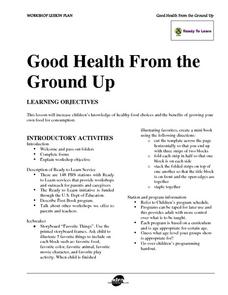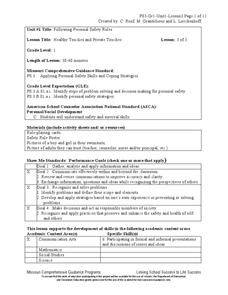Curated OER
Home Living/Life Skills: Face Washing
Having good hygiene skills is a very important part of living an independent life. Learners with special needs follow sequencing cards to practice washing their faces. They follow each step in the process and discuss the importance of...
Baylor College
About Air
Give your class a colorful and tasty representation of the components of the mixture that we call air. Pop a few batches of popcorn in four different colors, one to represent each gas: nitrogen, oxygen, argon, and carbon dioxide. The...
Curated OER
Healthy Kids: Creating Safe Communities And Schools
Students create a safety poster in small groups after a discussion on playground safety issues. They concentrate on bike safety, skating safety and general playground safety. After sharing the posters with the class they role-play safety...
Baylor College
Making Copies of an HIV Particle
In the second of five lessons about HIV, discover the mechanisms that allow the HIV virus to replicate. Using the models that they created the day before, learners examine the parts of the virus particle. The lesson plan does not say...
Curated OER
Literacy Lesson: Guided Reading
Here is a wonderful lesson designed for students with special needs. This well-thought-out lesson uses Big Books, familiar stories, and has a lot of review learning built into it. The book, The Keeping Quilt is used in the main part of...
Curated OER
How to Write an Essay: Secondary ed.
Whether introducing the structure of expository essays or reviewing the format with your high schoolers, take the time to check out this resource. Examples of seven common forms of introductory paragraphs and six types of conclusions, as...
Curated OER
Bank Tellers and Math
Second graders learn what math skills bank tellers need to do their jobs correctly.
Curated OER
Avoir, Être, et Le Passé Composé
The instructional activity begins with direct instruction: how and when do we use avoir and être to form the past tense? After identifying the verbs that use either avoir or être, French learners write about five things they did the week...
Curated OER
Workers Who Help Us At School (Part 1)
Students identify the roles and responsibilities of various school workers. They identify implications of what would happen in the school community if a school worker did not complete that role or responsibility.
Curated OER
Entrepreneurship: How to Begin
Students examine and identify the rudiments of a business plan. They locate and use resources about business plans on Internet.
BioEd Online
Gravity and Buoyancy
Would a baggie filled with water have the same shape sitting on a table as it would in a bucket of water? Why not? Allow learners to find out first-hand the effects of gravity acting alone on the baggie, as well as when gravity is...
Curated OER
Hunt the Fact Monster: February #3
In this search engine worksheet, 3rd graders will need to use factmonster.com to discover answers. Students will respond to 5 multiple choice questions using the given website.
Curated OER
Don't Slip!
Students measure, record, and graph the force of moving a block of wood along sand paper. In this friction lesson plan, students read a spring scale, collect data, construct a graph, and propose a model to explain how fiction works.
Curated OER
Entrepreneurship: Will it Work?
Consider to possibility of starting a business as a way to examine the concept of entrepreneurship. Learners develop and analyze feasibility studies, marketing strategies, proposals, and local census data all needed when starting a small...
Curated OER
Entrepreneurship: What Business Am I In?
To better understand entrepreneurship, learners examine the goals and mission statements in actual business plans, then outline a mission/vision statement for their own company. They develop objectives for the first three months of their...
Curated OER
Career Investigators - Jobs of Family Members
Students investigate the concept of a job and how they can differ for each household. They examine a tool box filled with different tools and identify the types of jobs could be done with them. Then the teacher conducts a class discussion.
Curated OER
All Around the Neighborhood - Part 2
Second graders review community leaders, their role and responsibility. After reviewing the job of a police officer, they write about the skills, roles and responsibilities a worker has on a provided silhouette. Students share their...
Curated OER
Telling a Story
Do your class members complain they don’t know what to write about? Give them disposable cameras and ask them to take pictures of 12 things that make them happy. After the pictures are developed, they are pasted on a poster board and...
Curated OER
Create a World
Students combine imaginative powers with known map-making techniques to create a whole new world.
Curated OER
Animals in Art
Second graders demonstrate visual awareness by listing seven to nine types of animals shown in the artwork on the tour. They draw three types of textured lines or patterns shown in the tour artwork and model an imaginary animal using clay.
Curated OER
Good Health from the Ground Up
Pupils examine healthy food choices and the benefits of growing their own food for consumption. They read the story "Favorite Things" and illustrate 5 favorite things. Students discuss types of foods that are healthy choices and why it...
Curated OER
Recycled Greeting Cards
Students create greeting cards from recycled products. They research how paper is recyled and the history of paper. They write free verse and create their own recycled paper. They use Microsoft Word to write their final drafts of verse...
Curated OER
Healthy Touches and Private Touches
First graders listen and share ideas. They role play situations where they would use the safety rules and share different kinds of touches that make them feel comfortable, uncomfortable or confused. They discuss what a person can do when...
Curated OER
Reading 2. Vocabulary Practice: Present and Past, Simple and Progressive
This worksheet serves a dual purpose. First, teach your class the 12 vocabulary words provided. Then, after they identify which word belongs in each sentence, have them identify which verb tense each sentence uses. They distinguish...

























